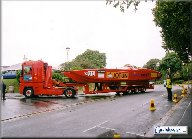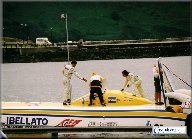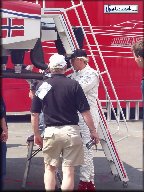The Boats

Weighing in at around 5 tonnes, each of the Class 1 fleet is approximately 13-14m in length and 3.5m wide. The boats are built using composite materials.
Over the years, safety has become a key concern and today's Class 1 boats are without doubt the safest they have ever been. The quest for speed has produced boats, engines and transmission systems which are inevitably more sophisticated and the use of Fibre Reinforced Polymer (FRP) with advanced composites using kevlar and carbon fibre has made them safer.
While several boat manufacturers (Tencara, MTI, CUV and Cougar) provide the fleet, the Dubai Victory Team is the only one on the circuit producing its own boats, not only for themselves but also for other teams. Most boats run petrol engines with the Italian Lamborghini 8.2litre, V12 the preferred power plant of many of the teams. The Victory Team run their own Victory V12 (based on the Lamborghini V12 but with a few tweaks here and there). In 2006 three boats will be running the Mercury 1075Sci V8 engine (Jotun and both Qatar boats).
In the cockpit, a satellite GPS system, trim indicators, engine data dashboards and instrument panels and warning lights keep the crew aware of the boat's progress during a race, while in some boats an escape hatch in the floor is an added safety feature in the event of an accident. The cockpit is also structured to withstand enormous impacts that may occur if a boat crashes at speeds in excess of 150mph.
The Crews
In each boat is a two-man crew consisting of the driver who navigates and steers the boat and a throttleman who dictates the speed and attitude. It is a combination that requires total trust - imagine driving a car and the person beside you has control of the accelerator - and a close working relationship.
People often believe that the crew simply jump into the cockpit and it's the guys who drive quickest that win. A simple enough theory but one that doesn't take into account, the skills and professionalism of pilots who regularly hurtle across the waves at over 160mph/250kmh.
 Both pilots will work closely with their pit crews to determine the type of propeller required for the conditions, the amount of fuel needed and race tactics. Propeller choice is crucial and can win or lose not only a race but also a championship.
Propeller design has seen the early three bladed bronze wheels superseded by stainless steel props of five and six blades for maximum efficiency and a top flight team might carry twelve pairs of props of differing pitches and diameters to accommodate differing sea conditions, fuel loads and handling characteristics. Both pilots will work closely with their pit crews to determine the type of propeller required for the conditions, the amount of fuel needed and race tactics. Propeller choice is crucial and can win or lose not only a race but also a championship.
Propeller design has seen the early three bladed bronze wheels superseded by stainless steel props of five and six blades for maximum efficiency and a top flight team might carry twelve pairs of props of differing pitches and diameters to accommodate differing sea conditions, fuel loads and handling characteristics.
|




 Both pilots will work closely with their pit crews to determine the type of propeller required for the conditions, the amount of fuel needed and race tactics. Propeller choice is crucial and can win or lose not only a race but also a championship.
Propeller design has seen the early three bladed bronze wheels superseded by stainless steel props of five and six blades for maximum efficiency and a top flight team might carry twelve pairs of props of differing pitches and diameters to accommodate differing sea conditions, fuel loads and handling characteristics.
Both pilots will work closely with their pit crews to determine the type of propeller required for the conditions, the amount of fuel needed and race tactics. Propeller choice is crucial and can win or lose not only a race but also a championship.
Propeller design has seen the early three bladed bronze wheels superseded by stainless steel props of five and six blades for maximum efficiency and a top flight team might carry twelve pairs of props of differing pitches and diameters to accommodate differing sea conditions, fuel loads and handling characteristics.